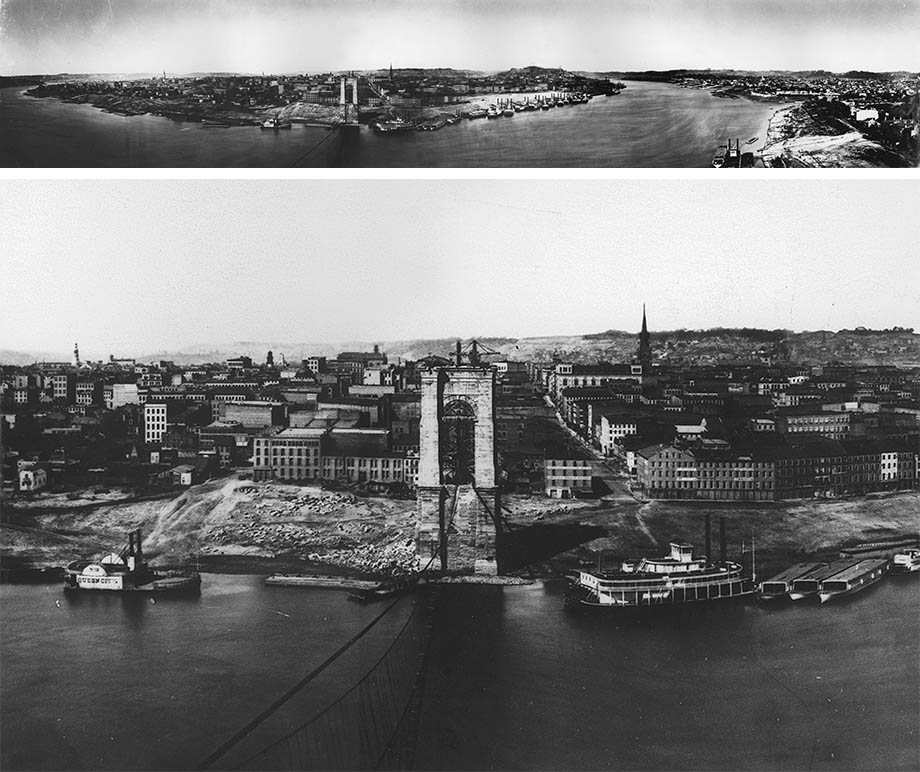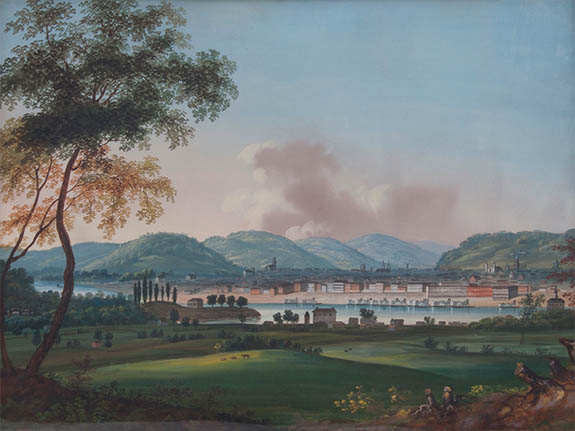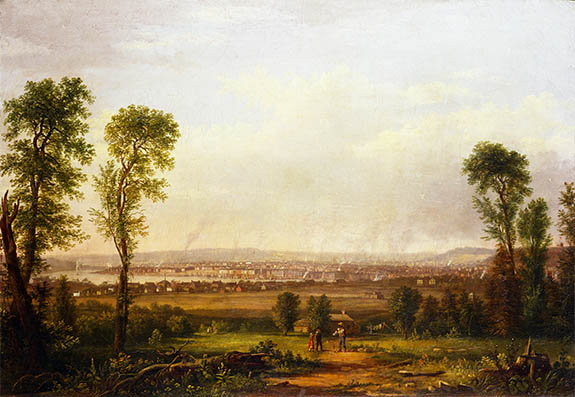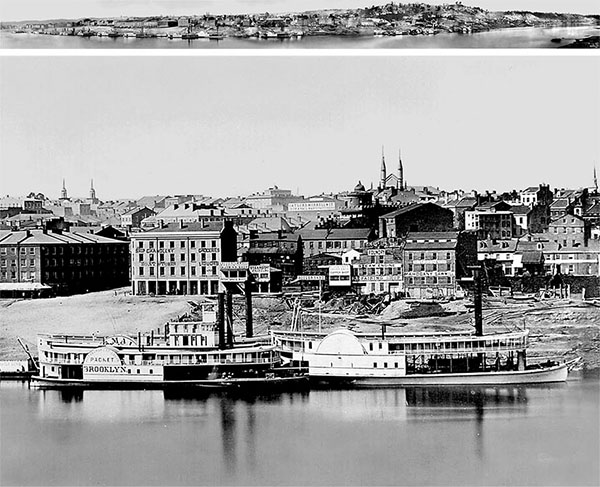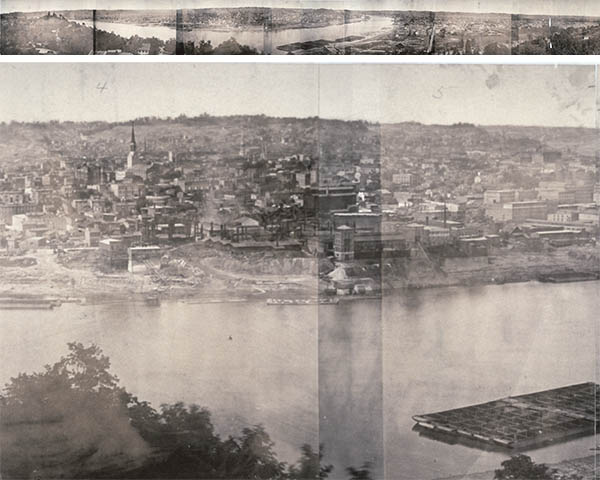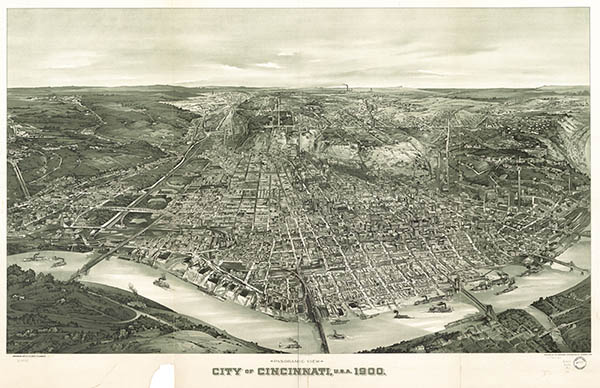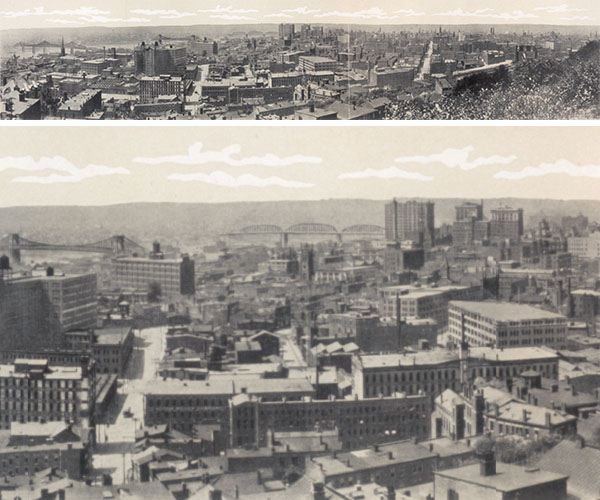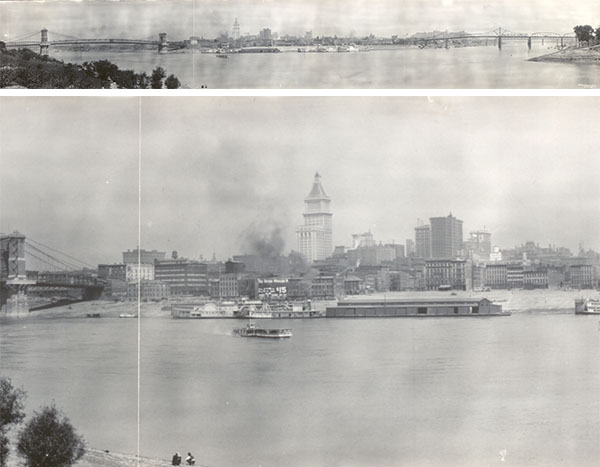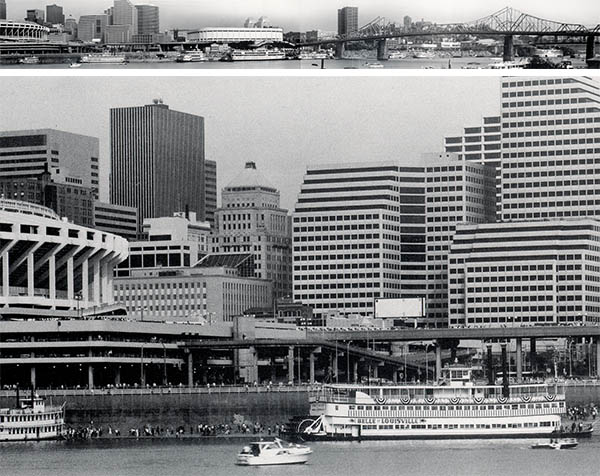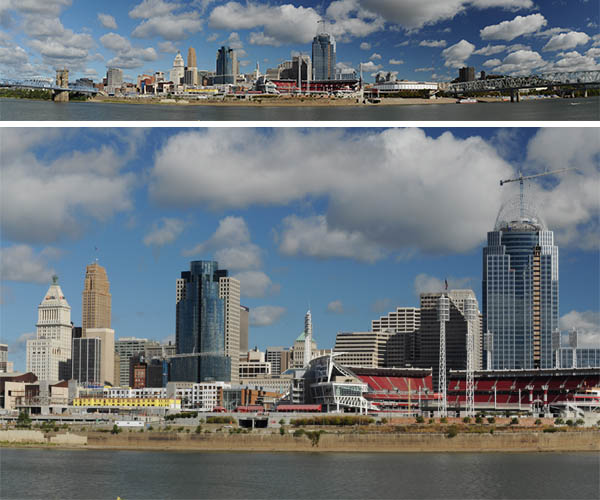This four-panel fish-eye panorama of Cincinnati was taken by an anonymous photographer. Based on the state of John Roebling’s Cincinnati-Covington suspension bridge it was likely done in 1865.1 It is a view of the city at the end of the Civil War.
Panoramic and bird’s-eye city views became rather fashionable in the second half of the nineteenth century and Cincinnati – set in a gently bending river valley with excellent vantage points from the Kentucky hills across the river – became a particularly attractive panoramic subject.
The earliest views of Cincinnati were, not surprisingly, in the form of paintings. The painter and lithographer John Caspar Wild prepared this watercolor of the city from Newport during his 1835–1836 stay:
Cincinnati From Behind Newport Barracks. Cincinnati Art Museum
The Hudson River School master Robert S. Duncanson painted the city from a similar vantage point in 1850:
Cincinnati From Covington, Kentucky. Cincinnati Art Museum
In 1848 the dagurreians Charles Fontayne and William Porter set up their camera in Newport and took the first panoramic photograph of not only Cincinnati but of any city – the one panorama to rule them all (see here for more):
Daguerrotype View of Cincinnati, Taken from Newport, Ky. 1848.
When Porter and Fontayne took their picture Cincinnati had a population of some 115,000 and was the sixth largest city in America. By the Civil War the population had grown to more than 160,000, half of whom were German immigrants. After the War the photographer John Winder took several panoramic wet-plate photos of the city:
View of Cincinnati, Ohio, ca.1866. LOC
Photographic View of Cincinnati, Covington and Newport, ca.1866. LOC
With the railroad replacing river traffic and the westward expansion of America the midwest population centers shifted to Chicago and St. Louis. Nevertheless by the turn of the 20th century Cincinnati had a population of 325,000. This perspective view by J. Trout shows the city in 1900:
City of Cincinnati, USA, 1900. LOC
The Cincinnati postcard publisher Albert Otto Kraemer took several panoramic photos between 1909–1914: 3
Central Business District – Cincinnati, USA, 1909. LOC
Waterfront of Cincinnati, O, 1914. LOC
The city’s first skyscraper – the Central Trust Building – was completed in 1913 (above). The 620-ft Carew Tower – Cincinnati’s tallest building for 80 years – was completed in 1931. Around 1950 the city’s population peaked at 500,000. After that the population shifted to the new northern suburbs and construction in the city center stagnated until the late 1960s when the multipurpose Riverfront stadium project was begun. The stadium would dominate the waterfront for the next 20 years. This silver gelatin print by Mel Mittermiller shows the city in 1988 and covers the same span as the Fontayne and Porter panorama:
Waterfront of Cincinnati, O. 1914
Two new stadiums replaced Riverfront Stadium in the early 2000s and a new tallest building – the tiara-topped Great American Tower – was completed in 2011. This is the skyline today:
Downtown Cincinnati, taken from Covington, Sep 2010. Wikimedia Commons
1. The German civil engineer John A. Roebling emigrated to America in 1831. He dabbled in utopian communities, then canals and railways and in 1840 began designing steel-rope suspension bridges. The Cincinnati-Covington suspension bridge was begun in 1856 but due to financial problems, weather delays and the Civil War was not completed until 1867. It was at the time the most ambitious suspension bridge in the world. As his son Washington wrote “The size and magnitude of this work far surpasses any expectations I had formed of it. It is the highest thing in this country. It will take me a week to get used to the proportions of everything around here.”
The same year that the bridge opened he began work on its suceessor – a bridge half again as long that would span the East River – the Brooklyn Bridge. See: Steinman, D. B. The Builders of the Bridge: the Story of John Roebling and his Son. New York: Harcourt, Brace and Co, 1945 (WorldCat).
2. John W. Winder learned photography in Massachusetts and later relocated to Cincinnati. He operated a photography studio, at various addresses, from 1855―1876. In adition to the standard daguerrotype portraits, carte-de-visits and cabinet cards, he shot many Cincinnati landmarks, including these panoramas. Sometime after 1876 he moved to New Orleans, where he became a full-time beekeeper. He was one of the first to raise and advertise for sale queen bees. He died of bronchitis at the age of 71 on 8 Apr 1900. See: Gleanings in Bee Culture 28;6. 15 Mar 1900. 318 (online).
3. The brothers Albert Otto and George A. Kraeamer began publishing private mailing cards in 1902. Their Kraeamer Art Company advertised itself as “photogravure manufacturers for the trade, art and reproductions, view books and post cards.” See: Powers, Esther. “Kraemer Postcards Leave Rich, Historic Legacy” (online).
22 Dec 2008, updated 3 Feb 2015 ‧ Photography
The City of Cincinnati:
